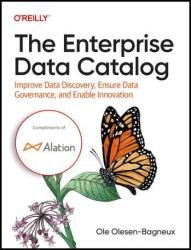 Название: The Enterprise Data Catalog: Improve Data Discovery, Ensure Data Governance, and Enable Innovation (Final Release)
Название: The Enterprise Data Catalog: Improve Data Discovery, Ensure Data Governance, and Enable Innovation (Final Release)Автор: Ole Olesen-Bagneux
Издательство: O’Reilly Media, Inc.
Год: 2023
Страниц: 216
Язык: английский
Формат: epub
Размер: 10.1 MB
How do you search for data? Combing the web is simple, but how do you search for data at work? It's difficult and time-consuming, and can sometimes seem impossible. This book introduces a practical solution: the data catalog. Data analysts, data scientists, and data engineers will learn how to create true data discovery in their organizations, making the catalog a key enabler for data-driven innovation and data governance.
Author Ole Olesen-Bagneux explains the benefits of implementing a data catalog. You'll learn how to organize data for your catalog, search for what you need, and manage data within the catalog. Written from a data management perspective and from a library and information science perspective, this book helps you:
Learn what a data catalog is and how it can help your organization
Organize data and its sources into domains and describe them with metadata
Search data using very simple-to-complex search techniques and learn to browse in domains, data lineage, and graphs
Manage the data in your company via a data catalog
Implement a data catalog in a way that exactly matches the strategic priorities of your organization
Understand what the future has in store for data catalogs
In fact, every day at work, we search and communicate with such difficulty that it reduces our company productivity by up to 10%. For data scientists, the numbers are even worse as they lose over half their time searching for relevant data. That substantially limits innovation based on data - and that is dangerous, as your company then risks losing its leverage with competitors.
Data catalogs have been invented to address these problems and solve them. Data catalogs provide a searchable overview of all the data in your company. Unfortunately, data catalogs are disregarded as a solution to inefficient search because they are often difficult to implement and require some up-front work. You have to organize your data before you can make it searchable, which could be seen as a huge hassle. You would also need to teach all of your users how to use the data catalog, which could lead to some resistance.
Who Should Read This Book:
Although I had the epiphany about the potential of a data catalog and it was crystal clear in my head, I was then faced with the battle of explaining the features to the important stakeholders of my company. Although I knew they would see the benefits of this tool if they only took the time to understand it, they were simply not interested, nor did they have time to study it. I had to come up with a way to reach them.
I went back to the idea of using the data catalog as an enterprise search engine. So, I asked myself, “What are people searching for? What would a data scientist be searching for? A data protection officer? A chief information security officer?” I decided to build demonstrations of the most vital data catalog features into small stories about specific stakeholders. Each slide deck had one central picture: a minimalist search bar with the company’s logo above it. I would explain the information need of a specific stakeholder, show the search in the search bar, reveal the result, then close with how the results could be used. In this way, I showed simple searches, complex searches, how to browse back and forth in the lineage of data, up and down in domains, and relationally in the graph that depicted our company. It had the same content as my previous demonstrations, but this time, it was explained from a stakeholder point of view: a specific person who was searching for something specific. And that worked.
The stakeholders not only got interested, but they also got excited. They now wanted the data catalog, because they understood that this tool was not just a collection of fancy features for data geeks. No, this tool was something way more fundamental: the data catalog could help them search and find the data they were looking for. I explained that, implemented with care, a data catalog has relevance for many of the employees in a company. This approach worked for me and my colleagues, and I hope that it will work for you and yours as well. At the end of the day, we are all searching for something. And we search all the time. The only thing is, at work, it is very difficult to search for whatever we are trying to find. And we take that for granted, as something that we must just accept.
I’m assuming you’re reading this book because you’re involved with planning to implement a data catalog, improve an existing one, sunset it, or simply trying to understand what kind of technology a data catalog is: what it does, how it should be used, and if it can help you in a certain way. You might be part of the offices of the legal counsel, chief data officer, data protection officer, or chief information officer. You might be a data engineer, data scientist, or data manager, or you might be part of the data governance team. If you are, then this book will help you understand what a data catalog is and how it will enable you to find exactly what you are searching for.
Скачать The Enterprise Data Catalog Improve Data Discovery, Ensure Data Governance, and Enable Innovation (Final Release)